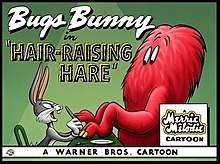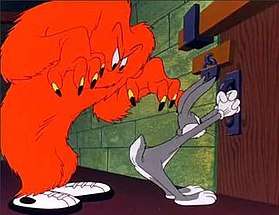Hair-Raising Hare
Hair-Raising Hare is a Warner Bros. Merrie Melodies cartoon, released in 1946. It was directed by Chuck Jones and written by Tedd Pierce.[1] It stars Bugs Bunny[2] and features the first appearance of Chuck Jones' imposing orange monster character, unnamed here, but in later cartoons named "Rudolph" and then "Gossamer".
| Hair-Raising Hare | |
|---|---|
 | |
| Directed by | Charles M. Jones |
| Produced by | Eddie Selzer |
| Story by | Tedd Pierce |
| Starring | Mel Blanc |
| Music by | Carl W. Stalling |
| Animation by | Ben Washam Ken Harris Basil Davidovich Lloyd Vaughan |
| Layouts by | Earl Klein |
| Backgrounds by | Robert Gribbroek |
| Color process | Technicolor |
Production company | |
| Distributed by | Warner Bros. Pictures The Vitaphone Corporation |
Release date | May 25, 1946 (U.S.) |
Running time | 7:41 |
| Language | English |
Plot

One dark night, as the camera pans across a dark, empty forest, Bugs is heard singing a stanza of "Sweet Dreams, Sweetheart" (introduced in Hollywood Canteen). When the camera zooms in on Bugs' rabbit hole, he pokes up, dressed in a nightshirt and holding a candle, and tells the audience that he feels he is being watched ("Eh, I don't know but, did you ever have the feeling you was being watched?") In fact, he is being watched via remote TV by an evil scientist (a caricature of actor Peter Lorre;[3][4] like Bugs, he is played by Mel Blanc), who is planning to catch a rabbit to provide dinner for his large, hairy, orange, sneaker-wearing monster.
The scientist lures Bugs to his castle via a shapely robotic female rabbit, complete with a large wind-up key in the back, and accompanied by Oh, You Beautiful Doll in the cartoon's underscore. Once Bugs gets to the castle (labeled "evil scientist" in neon lights) the evil scientist locks the door behind him. Bugs turns to him and says, "You don't need to lock that door, mac. I don't wanna leave." He proceeds to kiss the mechanical rabbit's hand, when suddenly the robot short-circuits and breaks into pieces. Bugs comments "That's the trouble with some dames... kiss 'em and they fly apart!"
Nonchalantly shrugging off this odd encounter, Bugs heads for the door, but the scientist stops and persuades him to stay, saying that he's got "another little friend who'd like to eat - uh, meet you [Bugs]." When it becomes clear that this "friend" is a ferocious beast, Bugs sizes up the situation, vigorously shakes the scientist's hand goodbye and launches into a schtick where he packs luggage for a vacation trip, accompanied by a very brassy rendition of California, Here I Come. He tells the scientist, "And don't think it hasn't been a little slice of heaven...'cause it hasn't." He then bolts for the door. The scientist then releases the monster. The rest of the cartoon is an extended chase between Bugs and the creature, with gags aplenty.
At one point, as Bugs is behind a door and the monster is trying to break through, Bugs desperately cries for a doctor ("Is there a doctor in the house?") A silhouette from the theater audience stands up and offers, "I'm a doctor." Bugs suddenly relaxes, grins, starts munching a carrot, and asks, "What's up, Doc?", just before the monster breaks through and the chase resumes.
Bugs and the monster pass by a mirror. The creature steps back to look into the mirror, whereupon his reflection comes to life, screams in horror and runs away toward the door. Albeit confused, he turns to the audience, shrugs, then takes off after Bugs. Bugs rushes up a staircase, but suddenly comes rushing back down, running into the monster and knocking him down. Bugs says not to go 'up there' because it's dark (similar to a gag from The Wabbit Who Came to Supper). Bugs disguises himself as a lamp, then, after the monster 'turns on' the bulbs in Bugs' ears, the rabbit dances away to the tune of Shuffle Off To Buffalo. From one end of a hallway, Bugs taunts the monster by calling him "Frankenstein!". The two keep running until a trapdoor on the floor opens, forcing Bugs to halt. While Bugs is tiptoeing backwards and praying, he bumps into the creature. He comes up with the idea to give him a manicure. He produces a table and a chair and starts working on the nails while he talks and acts like a female manicurist ("Oh, for shame! Just look at those fingernails! My, I'll bet you monsters lead in-teresting lives. I said to my girl friend just the other day, 'Gee, I'll bet monsters are in-teresting.' I said. The places you must go and the things you must see -- my stars! I bet you meet lots of in-teresting people too. I'm always in-terested in meeting in-teresting people. Now let's dip our patties in the water!") He puts the monster's fingers into a bowl of water, but it contains two mousetraps, which snap and catch his fingers, causing him to yelp in pain and shed some tears.
Bugs thinks he has escaped three times. The first time, the monster is hiding in a hole in the wall behind a painting. It seems that Bugs is not aware of the portrait's eyes following him, but then he plays a surprise prank by poking the portrait, and therefore the monster, in the eyes. The creature comes out from behind the wall, and while building up some speed to chase Bugs, realizes that the rabbit is likely hiding behind a painting he passes. He is about to play exactly the same eye-poking prank on Bugs, but right when he is about to carry it out, Bugs jumps the gun, pokes the monster in the eyes and disappears from the painting. As the creature jumps through the portrait and back behind the wall, Bugs jumps out.
This second time Bugs feels his escape is successful, the monster is actually following Bugs behind the wall. Bugs can hear footsteps copying his own in the hallway. After a short series of deliberate footstep games, Bugs marks the wall where he knows the creature is, and smashes the mark with a giant mallet. The monster's shape appears on the wall, the segment of wall falls and the barely conscious monster does the same.
Now, this third time he is sure he is free, Bugs plans to leave through the front door. But, he spots the creature in knight's armor, holding an axe above his head. Bugs heads off and reappears inside a locomotive-style jousting knight and, with his lance, smashes the monster into a wall. He becomes "Canned Monster". However, as Bugs saunters off toward the exit, singing to himself, the monster (who is now stretched out on the floor) gets the rabbit in his clutches. Bugs repeats his opening line ("Did you ever have the feeling you were being watched?") and the monster's expression changes from anger to anxiety. Bugs points to the audience and the creature, despite having already acknowledged the audience earlier, shrieks "PEOPLE!" and runs away screaming, breaking through a series of walls, leaving his cartoon silhouette in all of them.
Having "re-re-disposed of the monster", Bugs is about to "exit stage right" (although this time, he is actually going stage left), when the female robo-rabbit re-appears, intact, and again accompanied by Oh, You Beautiful Doll. Bugs snickers, "Mechanical!," but then the robot smooches him on the cheek, leaving a lipstick mark on the smitten rabbit ("Well, so it's mechanical!") He assumes a robot-like gait (with his tail magically rotating like the robot's wind-up key) and follows her off the screen.
Cast
- Mel Blanc as Bugs Bunny, Gossamer and Scientist
Notes
This was the first short to use the 1946-47 rings, evident from blue rings, one red ring, and red background.
This was the final appearance of Chuck Jones' Bugs Bunny design, as starting with his next Bugs Bunny cartoon (A Feather in His Hare), he would use Robert McKimson's design for the character.
After, many Bugs cartoon titles that substituted "hare" for "hair" in a punny way, this title includes both words, as homophones.
This short was later remade as ("Water, Water Every Hare").
Availability
- Hair-Raising Hare is currently available in several issues of the Looney Tunes Golden Collection DVD box sets. It has been released independently on Disc 3 of the Looney Tunes Golden Collection: Volume 1. The short also appears in its entirety in the documentary Bugs Bunny: Superstar Part 2, which is available as a special feature on Disc 2 of the Looney Tunes Golden Collection: Volume 4. It can also be found in What's Up, Doc: A Salute to Bugs Bunny part 2 as a Special Feature on Looney Tunes Golden Collection Volume 3, disc 3, as well as disc 1 of The Essential Bugs Bunny.
- Hair-Raising Hare is also featured on side 8 of the LaserDisc release "The Golden Age of Looney Tunes: Volume 1".
- Hair-Raising Hare is also available as a special feature on the DVD Bugs Bunny's Howl-oween Special.
- Hair-Raising Hare is also available on Looney Tunes Platinum Collection: Volume 3.
Sources
- Greenberg, Harvey Roy (2004). "Heimlich Maneuvers: On A Certain Tendency of Horror and Speculative Cinema". In Shneider, Steven Jay (ed.). Horror Film and Psychoanalysis: Freud's Worst Nightmare. Cambridge University Press. ISBN 9781139453684.
- Youngkin, Stephen D. (2005). "Being Slapped and Liking It". The Lost One: A Life of Peter Lorre. University Press of Kentucky. ISBN 9780813137001.
References
- Beck, Jerry; Friedwald, Will (1989). Looney Tunes and Merrie Melodies: A Complete Illustrated Guide to the Warner Bros. Cartoons. Henry Holt and Co. p. 167. ISBN 0-8050-0894-2.
- Lenburg, Jeff (1999). The Encyclopedia of Animated Cartoons. Checkmark Books. pp. 60–61. ISBN 0-8160-3831-7. Retrieved 6 June 2020.
- Greenberg (2004), p. 130
- Youngkin (2005), p. 214
External links
- (

- Hair-Raising Hare on IMDb
| Preceded by Hare Remover |
Bugs Bunny Cartoons 1946 |
Succeeded by Acrobatty Bunny |